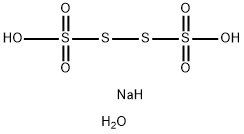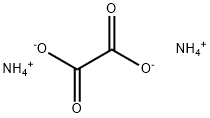Ammonium thiosulfate
Synonym(s):Diammonium thiosulfate
- CAS NO.:7783-18-8
- Empirical Formula: H8N2O3S2
- Molecular Weight: 148.21
- MDL number: MFCD00015965
- EINECS: 231-982-0
- SAFETY DATA SHEET (SDS)
- Update Date: 2025-01-27 09:38:02

What is Ammonium thiosulfate?
Description
Ammonium thiosulfate is a white crystallinesolid with an ammonia odor. Molecular weight= 148.21;Freezing/Melting point= 150 C [decomposes ,50℃(solution); .100℃ (anhydrous crystals)]. HazardIdentification (based on NFPA-704 M Rating System):Health 1, Flammability 0, Reactivity 0. Highly soluble inwater.
Chemical properties
white or colourless crystals
Chemical properties
Ammonium thiosulfate is a white crystalline solid with an ammonia odor.
Physical properties
Colorless, monoclinic crystal; hygroscopic; decomposes on heating above 100°C; density 1.679 g/cm3; very soluble in water (64 g/100 g at 20°C), insoluble in alcohol, and slightly soluble in acetone.
The Uses of Ammonium thiosulfate
Ammonium thiosulfate finds application for leaching of gold and silver since it forms strong complexes. It is widely utilized as a photographic fixing agent, which acts quicklier than sodium thiosulfate fixers. It serves as a fertilizer. It acts as an additive to coal-waste mixtures to inhibit the formation of dangerous dioxins and furans. It is used as an analytical reagent in laboratories.
The Uses of Ammonium thiosulfate
To clean "white" metal; in photography; in lubricants for metal cold-working.
General Description
AMMONIUM THIOSULFATE is a white crystalline solid. AMMONIUM THIOSULFATE is very soluble in water. The primary hazard is the threat posed to the environment. Immediate steps should be taken to limit its spread to the environment. AMMONIUM THIOSULFATE is used in photography, in chemical analysis, and for many other uses.
Air & Water Reactions
Hygroscopic. Very soluble in water.
Reactivity Profile
AMMONIUM THIOSULFATE is sensitive to heat. AMMONIUM THIOSULFATE is incompatible with magnesium and aluminum powder. Mixtures with sodium chlorate can cause an exothermic reaction which can then decompose explosively. . Reacts with strong oxidizers such as chlorates, nitrates, and nitrites to release toxic ammonia, hydrogen sulfide, and sulfur trioxide gases. Will not polymerize. Ammonia, hydrogen sulfide, and oxides of nitrogen and oxides of sulfur may form in fires [USCG, 1999].
Health Hazard
Inhalation of dust may irritate respiratory system. Ingestion could be harmful. Contact with eyes or skin may cause irritation.
Fire Hazard
Special Hazards of Combustion Products: Toxic ammonia, hydrogen sulfide, and oxides of nitrogen and sulfur may form in fires.
Agricultural Uses
Ammonium thiosulphate, [(NH4)2S2O3 or ATS] is a
crystalline salt, the aqueous solution of which is
commonly used as a liquid fertilizer. Crystalline
ammonium thiosulphate contains 19% nitrogen and 43 %
sulphur and its aqueous solution contains 12% nitrogen
and 26 % sulphur.
Ammonium thiosulphate is compatible with nitrogen
and nitrogen-potassium solutions, which are neutral or
slightly acidic (pH 5.8). It is also used as a suspension:
As it is non-corrosive, it can be stored in steel or
aluminumdrums.
Ammonium thiosulphate is prepared by the reaction
of sulphur dioxide and aqueous ammonia, followed by a
further reaction with elemental sulphur.
ATS can be applied directly to soils or as a foliar spray
through sprinkler irrigation systems. When applied to soils,
ATS decomposes into ammonium sulphate and colloidal
sulphur. The ammonium sulphate is available immediately
to plants, while the sulphur gets oxidized over a period of
time to sulphate ion (SO42-) It is thus available to plants for
a longer time.
Ammonium thiosulphate also acts as a urease
inhibitor. When added to a urea-ammonium nitrate
solution, it inhibits urease activity for a month or so. In
industry, it is also used as a photographic fixing agent,
analytical reagent, fungicide and as a brightener in silverplating
baths.
Safety Profile
Moderately toxic by ingestion.When heated to decomposition it emits toxic vapors ofNH4- and SOx.
Potential Exposure
Used as an agricultural chemical and fungicide, metal lubricant; in cleaning metals; in photographic chemicals, making other chemicals. A laboratory reagent.
First aid
If this chemical gets into the eyes, remove anycontact lenses at once and irrigate immediately for at least15 min, occasionally lifting upper and lower lids. Seekmedical attention immediately. If this chemical contactsthe skin, remove contaminated clothing and wash immediately with soap and water. Seek medical attention immediately. If this chemical has been inhaled, remove fromexposure, begin rescue breathing (using universal precautions, including resuscitation mask) if breathing hasstopped and CPR if heart action has stopped. Transferpromptly to a medical facility. When this chemical hasbeen swallowed, get medical attention. Give large quantities of water and induce vomiting. Do not make an unconscious person vomit.
storage
Color Code—Green: General storage may beused. Prior to working with this chemical you should betrained on its proper handling and storage. Store in tightlyclosed containers in a cool, well-ventilated area away fromoxidizers, acids, water, or combustible materials.
Shipping
UN3077 Environmentally hazardous substances, solid, n.o.s., Hazard class: 9; Labels: 9-Miscellaneous hazardous material, Technical Name Required.
Incompatibilities
Contact with sodium chlorate may cause a violent reaction. Corrodes brass, copper, and copperbased metals.
Waste Disposal
Incinerate. It may be possible to dispose of waste material at a municipal facility if treated, neutralized and oxidized.
Properties of Ammonium thiosulfate
| Melting point: | 150 °C (lit.) |
| Density | 1.679 g/mL at 25 °C (lit.) |
| solubility | H2O: very soluble(lit.) |
| form | Crystalline Powder |
| color | White |
| Odor | Ammonical odour |
| Water Solubility | Soluble in water, slightly soluble in acetone. Insoluble in ethanol and diethyl ether. |
| Sensitive | Hygroscopic |
| Merck | 14,562 |
| Stability: | Stable. Hygroscopic. |
| InChI | InChI=1S/2H3N.H2O3S2/c;;1-5(2,3)4/h2*1H3;(H2,1,2,3,4) |
| CAS DataBase Reference | 7783-18-8(CAS DataBase Reference) |
| EPA Substance Registry System | Ammonium thiosulfate (7783-18-8) |
Safety information for Ammonium thiosulfate
| Signal word | Warning |
| Pictogram(s) |
 Exclamation Mark Irritant GHS07 |
| GHS Hazard Statements |
H302:Acute toxicity,oral H319:Serious eye damage/eye irritation |
| Precautionary Statement Codes |
P305+P351+P338:IF IN EYES: Rinse cautiously with water for several minutes. Remove contact lenses, if present and easy to do. Continuerinsing. |
Computed Descriptors for Ammonium thiosulfate
| InChIKey | XYXNTHIYBIDHGM-UHFFFAOYSA-N |
| SMILES | S(=S)(=O)(O)O.N.N |
Ammonium thiosulfate manufacturer
New Products
3-Iodophenylacetic acid 3-Pyridineacetonitrile, α-hydroxy- 2-Propanamine, 1-chloro-, hydrochloride (9CI) 3-(hexyloxy)-4-(pyridin-3-yl)-1,2,5-thiadiazole 2-Hexyn-1-ol Dibenzo-18-crown-6 Nickel(II) perchlorate hexahydrate, 98% 4-Bromophenylacetonitrile, 95% 3-Bromo-4-fluoroaniline, 97% Sodium tetraborate decahydrate, 98% Palladium(II) acetate, trimer, Pd 99% 4-Bromo-2-chlorotoluene, 97% N N Dimethylformamide Dimethyl Acetal (Dmf Dma) 2,3-Dichloro Benzoyl Cyanide [Side Chain] Bis(2-Chloroethyl) Amine Hydrochloride L-Glutamic Acid Diethyl Ester Hydrochloride 5-(Difluoromethoxy)-2-Mercaptobenzimidazole 1-Ethyl-3-(3-Dimethylaminopropyl)-Carbodiimide Hydrochloride [EDC Hcl] 1,4-Napthoquinone Bromoiodomethane Sodium Bicarbonate Methylene Dichloride (MDC) Ethyl Acetate Indole-3-Carbinol (I3C)Related products of tetrahydrofuran








You may like
-
 7783-18-8 Ammonium thiosulfate 98%View Details
7783-18-8 Ammonium thiosulfate 98%View Details
7783-18-8 -
 7783-18-8 98%View Details
7783-18-8 98%View Details
7783-18-8 -
 7783-18-8 99%View Details
7783-18-8 99%View Details
7783-18-8 -
 Ammonium thiosulphate CAS 7783-18-8View Details
Ammonium thiosulphate CAS 7783-18-8View Details
7783-18-8 -
 Ammonium thiosulfate 96.00% CAS 7783-18-8View Details
Ammonium thiosulfate 96.00% CAS 7783-18-8View Details
7783-18-8 -
 AMMONIUM THIOSULPHATE Extra Pure CAS 7783-18-8View Details
AMMONIUM THIOSULPHATE Extra Pure CAS 7783-18-8View Details
7783-18-8 -
 Ammonium thiosulfate CAS 7783-18-8View Details
Ammonium thiosulfate CAS 7783-18-8View Details
7783-18-8 -
 132945-75-6 (S)-1-Boc-3-methanesulfonyloxy-pyrrolidine 98+View Details
132945-75-6 (S)-1-Boc-3-methanesulfonyloxy-pyrrolidine 98+View Details
132945-75-6
